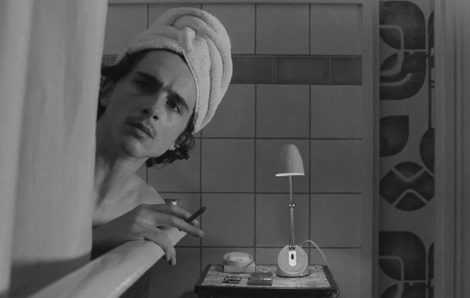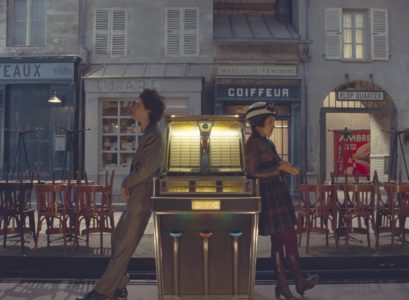The French Dispatch
Tropic Sprockets by Ian Brockway
[mr_rating_result]Director Wes Anderson strikes again in typical madcap fashion with his latest “The French Dispatch.” This is Anderson’s valentine to The New Yorker magazine, a kind of pop-up book homage to the iconic institution. Quirky, colorful and deadpan, at once hyper yet breezy, this prismatic billet-doux will entertain and perhaps confuse. For fans of the auteur, it has all of the usual hallmarks.
 For starters, New Yorker writer Mavis Gallant is affectionately given a tribute in the character of Krementz (Frances McDormand), who is profiling student uprisings. She is in bed with a young anarchist (Timothée Chalamet). Owen Wilson’s bicycle riding character is based on Joseph Mitchell who wrote about common-place events in and around the city.
For starters, New Yorker writer Mavis Gallant is affectionately given a tribute in the character of Krementz (Frances McDormand), who is profiling student uprisings. She is in bed with a young anarchist (Timothée Chalamet). Owen Wilson’s bicycle riding character is based on Joseph Mitchell who wrote about common-place events in and around the city.
In what is arguably the best sequence, actor Adrien Brody performs as a version of art dealer Lord Duveen who stops at nothing to buy a Bacon / DeKooning-ish canvas from a psychotic patient (Benicio Del Toro). There are several slapstick moments and questions about the shock of art, accompanied by facial mugging for the camera.
A quasi sketch of James Baldwin is here too in the actor Jeffrey Wright.
Bill Murray is a curmudgeon editor of the magazine based on Harold Ross.
The pace is wild and frenetic a bit like Mack Sennett’s Keystone Cops as if painted by Toulouse Lautrec. Smooth and rapidly flowing here and there in huge blocks of color, only to suddenly retract in tiny squares of activity like a journalist Advent calendar, this film moves across the screen very like The New Yorker’s actual pages. This is an achievement in itself.
 There are also cinematic nods to Chaplin, Trauffaut and von Trier and painterly visual quips celebrating Jackson Pollock and Francis Bacon.
There are also cinematic nods to Chaplin, Trauffaut and von Trier and painterly visual quips celebrating Jackson Pollock and Francis Bacon.
The references in “The French Dispatch” are a hundred fold and a lot is within this amphetamine candy-box of a film, though a good many might well be uncertain as to what the symbols or the story actually means. It is a safe bet to say that much of it pertains specifically to The New Yorker and that is well taken.
A lot of personalities laugh, roll their eyes, light canons and grimace. At times the film feels like an appendix to “Midnight in Paris” as the parade of past celebrities march along the film.
Though the visual cues may only be intended for fans of the magazine, the untutored among us will grasp the realization that a magazine is a treasure and that each writer is a kind of eccentric wonder that informs usually with a cigarette, composing by hand or machine. A journalist often chases the moon away with endless coffees, doing whatever it takes to write a story and we are all the better for it.
Write Ian at ianfree11@yahoo.com


Ratings & Comments
[mr_rating_form]